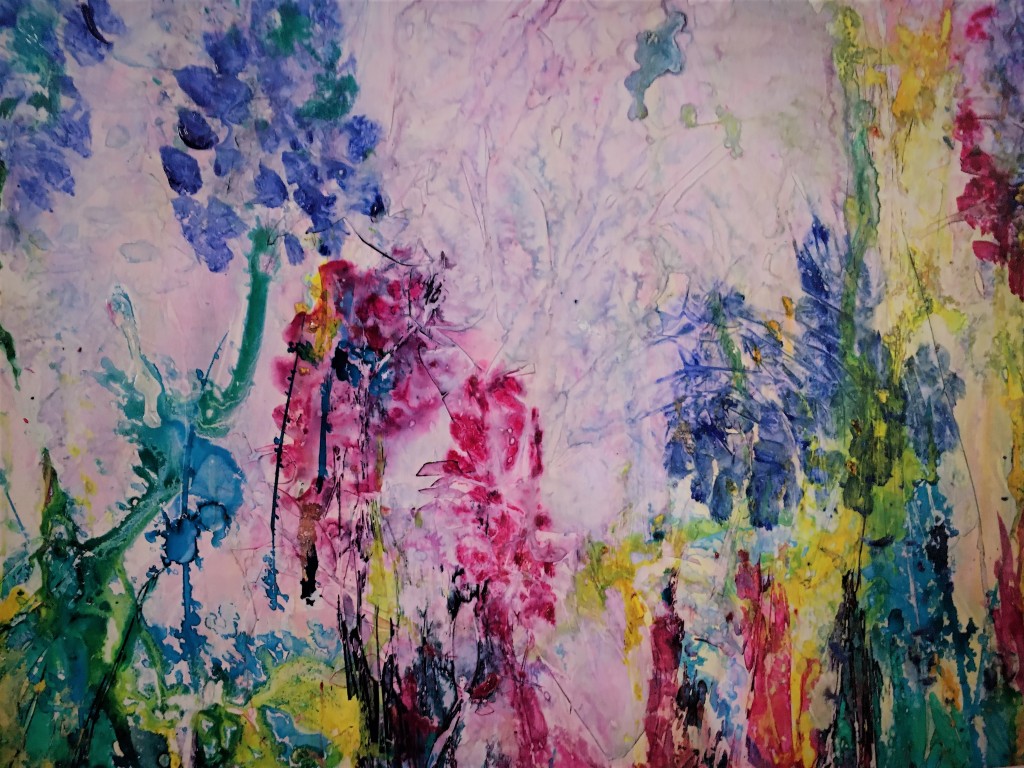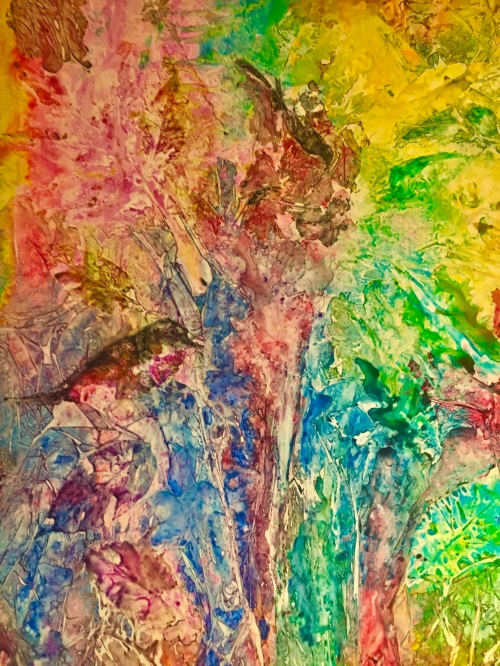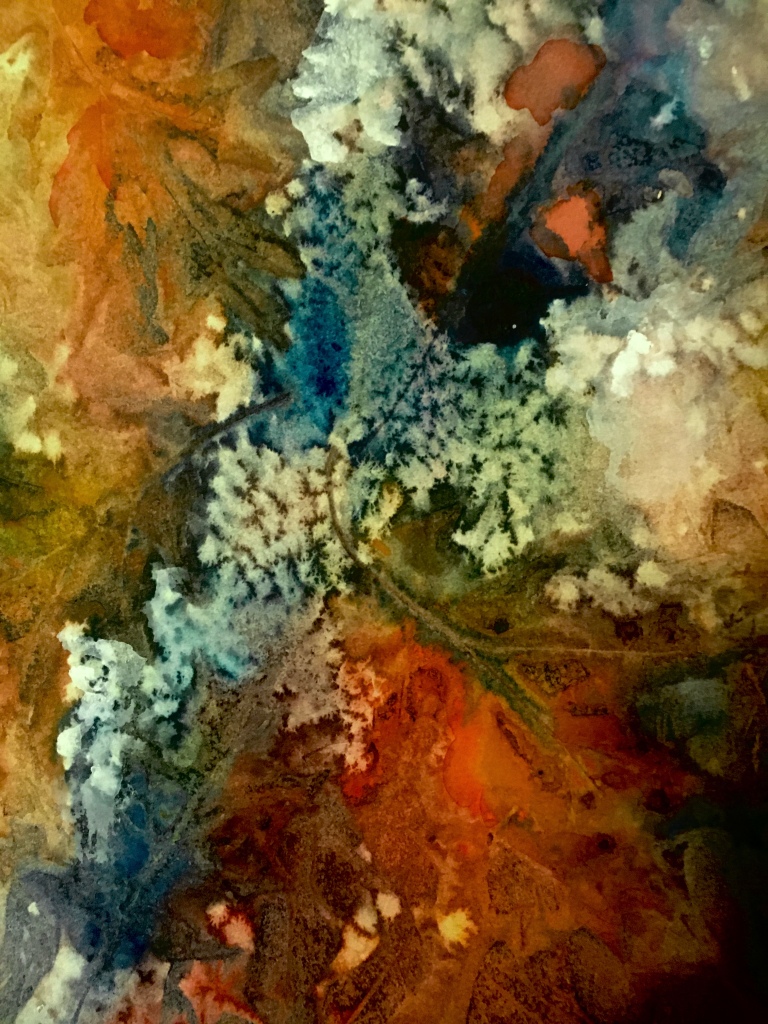Another DVD I watch and absorb again and again is Taylor Ikin’s DANCING WITH YUPO. This Florida-based fine artist’s (1 hour, 58 minute) tutorial has probably done as much, if not more, to free me up and send me painting on my way—as any other resource in my sizeable home library of books and DVDs.
The huge secret (but not REALLY a secret!) is Taylor Ikin’s use of YUPO® paper, which is actually not paper but rather a shiny washable plastic–coupled with her method of always standing and moving around* while working, and using totally-generous, extra-humungous amounts of paint mainly applied with a 2″ or larger square brush.
In her DVD Taylor Ikin depicts a downhill stream tumbling over rocks, with a forest in the background and lots of wild growth along the banks. Taylor begins by spritzing the sheet of YUPO with her spray bottle of water, and applying thick brush loads of rich undiluted colors for woods, water, foliage, rocks, and botanical stuff along the forest floor and riverbanks.
Taylor slosh/slosh/sloshes with brilliant, juicy straight-from-the-tube watercolors abundantly slathered on her brush which has been dipped in a commodious bucket of water. (I normally use marinara sauce jars large enough to accommodate my 4″ wash brush, and a gallon ice cream pail for my water supply—the pail for rinsing and letting the pigments settle on the bottom, and one or two of the glass jars for fresh clean water.)
Then with her clean wet brush, Taylor begins to delineate water from land, while creating chunky textural tree shapes in the background. Next, the forest foliage and groundcover evolve. With YUPO, this is super easy, as any swipe of a brush or paper towel brings the wet painting surface back to its original white and ready for more action. (When the paint is dry, a wet brush or wet paper towel will restore the white. And if unhappy with any stage of the process on YUPO, one may hold the piece under a gushing faucet or float it in a bathtub of water.)
When Taylor feels her initial rendering is satisfactory, she recommends letting the painting dry**, perhaps even overnight. When dry, the work is ready for tweaking and fine-tuning: as Taylor puts it, deciding “What will make this a better painting.” Now is the time-consuming stage of lifting, re-applying the shapes in a different way, making new shapes, removing colors, adding new colors, standing and looking at the work from a distance, holding the painting sideways/upside down/and in a large mirror, etc. (I sometimes tweak and fine-tune for hours over a period of days, or even a couple of weeks. My YUPO paintings usually consume more time than those on Arches 140# rag paper, because the YUPOs provide flexibility and so many more options.)
I have read books and watched tutorials by other YUPO artists, and quite frankly I have not warmed up to their work. Excellently crafted, but simply not what I would want to hang on my walls. But Taylor Ikin’s work has that magical quality to which I am inexorably drawn. Try GOOGLING her, and maybe you will be drawn as well.
YUPO is the perfect ground for the abstract realism style that I love. It is perhaps the easiest surface for beginning painters to use because (unless you desire to create detailed, representational art that resembles a photograph) YUPO is encouragingly NO-FAIL Every blob and drip of paint that blends with other drips and blobs will be beautiful. A few quick blasts of diverse colors on wet YUPO are often “suitable for framing”. But when more painstaking hours are invested, the rewards are even more incredibly satisfying.
One can play forever, with just one sheet of YUPO, painting and rinsing off the paint, experimenting with colors and brushstrokes. Or finger strokes. I have rediscovered the joy of finger painting, due to the fact that I have long hair and lots of it. Frequently I spy a wisp of my hair in a work in progress. I dislike hair in a painting almost as much as I hate to find it in my food! In the process of removing a hair with my pinky, gorgeous swirls will surface on YUPO.
Texture is easily achieved on YUPO—either by the application of modeling paste to make mountains, rocks, and tree trunks, or by dribbling texture medium onto the painted surface. Salt and cling film (plastic food wrap) build texture as well.
The acrylic inks are vibrant on YUPO paper. Another favorite technique is the slathering of gouache over water-colored areas. The gouache may be built up impasto, to fashion floral still lifes or wild landscapes, while looking amazingly like oil paint. I always spray my finished YUPO paintings with an acrylic fixative; this not only prevents smudging and smearing paint forever, but the fixative makes a lovely shine (although matt fixatives may be used if so desired). Also, the acrylic spray will prevent the impasto gouache areas from flaking.
Thank you, Taylor Ikin, for your continual inspiration from DANCING WITH YUPO! I have always loved to dance! 🙂 Here is a fresh off-the-messy-palette YUPO piece by moi. It is titled “Irides”. I can’t stop painting irides. Although I’m certainly not to be compared with Monet (YIKES!) that master and I do have something in common: repetition of a beloved subject. Monet did haystacks and water lilies among other topics. I do irides, along with woods, mountains, etc. What a good life!

Margaret L Been — February 25th, 2017
*Standing and moving around are the way to go, for me, as I have chronic orthopedic pain for which constant movement is the best medicine. The pain ramps up greatly at night when I am lying in bed. Rather than lie there and hurt (that would be STUPID!) I get up and move around our home—yes and sometimes dance, to the waltzes of Erik Satie as well as WITH YUPO. 🙂
**I am not a fan of drying paintings with a hair dryer, and rarely do this. But once I tried it on a YUPO piece. Not good! Too much heat, too close to the painting ground and voilà—shriveled-up art.
Read Full Post »



















